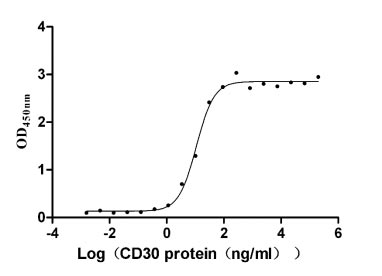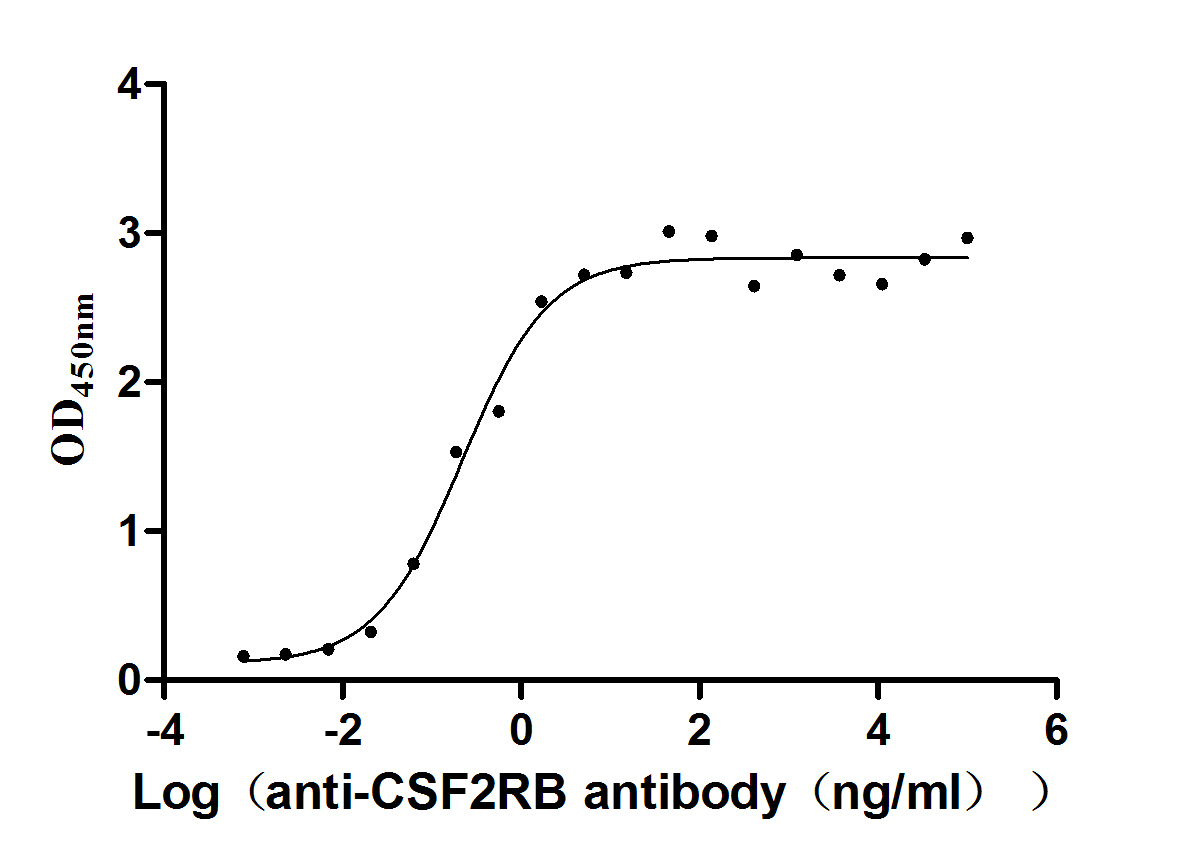Recombinant Rat 5-hydroxytryptamine receptor 3A (Htr3a)
-
中文名称:大鼠Htr3a重组蛋白
-
货号:CSB-CF010890RA
-
规格:
-
来源:in vitro E.coli expression system
-
其他:
产品详情
-
基因名:Htr3a
-
Uniprot No.:
-
别名:Htr3a; 5ht3; Htr3; 5-hydroxytryptamine receptor 3A; 5-HT3-A; 5-HT3A; 5-hydroxytryptamine receptor 3; 5-HT-3; 5-HT3R; Serotonin receptor 3A; Serotonin-gated ion channel receptor
-
种属:Rattus norvegicus (Rat)
-
蛋白长度:Full Length of Mature Protein
-
表达区域:24-483
-
氨基酸序列SRRRATQAHSTTQPALLRLSDHLLANYKKGVRPVRDWRKPTLVSIDVIMYAILNVDEKNQ VLTTYIWYRQFWTDEFLQWTPEDFDNVTKLSIPTDSIWVPDILINEFVDVGKSPSIPYVY VHHQGEVQNYKPLQLVTACSLDIYNFPFDVQNCSLTFTSWLHTIQDINISLWRTPEEVRS DKSIFINQGEWELLGVFTKFQEFSIETSNSYAEMKFYVVIRRRPLFYAVSLLLPSIFLMV VDIVGFCLPPDSGERVSFKITLLLGYSVFLIIVSDTLPATAIGTPLIGVYFVVCMALLVI SLAETIFIVQLVHKQDLQRPVPDWLRHLVLDRIAWLLCLGEQPMAHRPPATFQANKTDDC SAMGNHCSHVGSPQDLEKTSRSRDSPLPPPREASLAVRGLLQELSSIRHSLEKRDEMREV ARDWLRVGYVLDRLLFRIYLLAVLAYSITLVTLWSIWHYS
Note: The complete sequence including tag sequence, target protein sequence and linker sequence could be provided upon request. -
蛋白标签:N-terminal 10xHis-tagged
-
产品提供形式:Liquid or Lyophilized powder
Note: We will preferentially ship the format that we have in stock, however, if you have any special requirement for the format, please remark your requirement when placing the order, we will prepare according to your demand. -
缓冲液:Lyophilized from Tris/PBS-based buffer, 6% Trehalose, pH 8.0
-
储存条件:Store at -20°C/-80°C upon receipt, aliquoting is necessary for mutiple use. Avoid repeated freeze-thaw cycles.
-
保质期:The shelf life is related to many factors, storage state, buffer ingredients, storage temperature and the stability of the protein itself.
Generally, the shelf life of liquid form is 6 months at -20°C/-80°C. The shelf life of lyophilized form is 12 months at -20°C/-80°C. -
货期:Basically, we can dispatch the products out in 1-3 working days after receiving your orders. Delivery time may differ from different purchasing way or location, please kindly consult your local distributors for specific delivery time.Note: All of our proteins are default shipped with normal blue ice packs, if you request to ship with dry ice, please communicate with us in advance and extra fees will be charged.
-
注意事项:Repeated freezing and thawing is not recommended. Store working aliquots at 4°C for up to one week.
-
Datasheet & COA:Please contact us to get it.
相关产品
靶点详情
-
功能:This is one of the several different receptors for 5-hydroxytryptamine (serotonin), a biogenic hormone that functions as a neurotransmitter, a hormone, and a mitogen. This receptor is a ligand-gated ion channel, which when activated causes fast, depolarizing responses in neurons. It is a cation-specific, but otherwise relatively nonselective, ion channel.
-
基因功能参考文献:
- Data support a functional role for serotonergic signaling in the mesolimbic pathway on motivated behavior, and demonstrate that 5-HT3 serotonin receptors differentially modulate food consumption in a region-dependent manner. PMID: 28115218
- This study demonstrates that AITC-induced nociception in vivo depends on TRPA1 and is decreased by the blockade of the NK1 receptor for SP, the H1 receptor for histamine and the 5-HT1A and 3 receptors for 5-HT PMID: 27904941
- Study concludes that the serotonin 3 receptor does not play a unique role in mediating stress-induced hyperalgesia related to temporomandibular joint nociception. PMID: 25913635
- The inhibition of I(5-HT3) by WIN55,212-2 is probably new one of peripheral analgesic mechanisms of WIN55,212-2, but the mechanism by which WIN55,212-2 inhibits I(5-HT3) warrants further investigation. PMID: 22528232
- glucose may also be able to modulate the ability of GI vagal afferent neurons to respond to the released 5-HT, via regulation of neuronal 5-HT(3) receptors PMID: 22845622
- Activation of 5-HT3 receptors in the posterior insular cortex is important for nausea-induced conditioned disgust reactions. Those in the anterior IC are involved in the production of conditioned taste avoidance. PMID: 23035083
- Acute myocardial ischemia augments the Bezold-Jarisch reflex induced via activation of TRPV1 and 5-HT(3) receptors located on sensory vagal nerves in the heart. PMID: 22358093
- Spinal 5-HT(3) receptors play an important role during development and maintenance of pain evoked long-term behaviors. PMID: 22289689
- 5-HT3R may play a role in initiation of the nociceptive response. PMID: 21186576
- 5-HT3 receptors in the basal forebrain exert a tonic sympathoinhibitory action that is mediated via the local release of angiotensin in the septal nuclear complex. PMID: 20817619
- Data indicate that the hypotensive response observed after pharmacological stimulation of central 5-HT(3) receptors depends on the functional integrity of brain mu, kappa and delta opioid receptors. PMID: 21514668
- 5-HT(3) receptor-mediated somatostatin-dependent secretoinhibitory pathway is suppressed in the water-immersion restraint stressed rats PMID: 21291881
- results of this study suggest that 5-HT(3) receptors in the posterior ventral tegmental area of the alcohol-preferring rat may be involved in regulating ethanol self-administration PMID: 20682192
- results suggest that 5-HT is released from serotoninergic neurons, their processes and enterochromaffin cells. The effect of 5-HT mediated by 5-HT3 receptors involves distinct neuronal and non-neuronal pathways which modulate gastric acid secretion. PMID: 20359130
- investigated the role of central 5-HT3 receptors on the control of blood glucose in stressed and non-stressed rats in both fasted and fed states PMID: 11972287
- To identify the interaction of amino acids in binding loop E with 5-HT3R ligands, alanine mutations of residues throughout the loop have been constructed and evaluated for alteration in binding affinity of 5 different classes of 5-HT3R ligands. PMID: 12079500
- 5-HT3 receptor-like immunoreactivity is found in fibers sparsely distributed throughout the cerebellum; most of them are seen in the cerebellar cortex as fine varicose 5-HT3-positive axonal processes. PMID: 12084412
- 5-HT3A-short and alpha4-nAChR expressed in interneurons. No 5-HT3B or 5-HT3A-long. 2-Aminoethyl methanethiosulphonate enhanced 5-HT3R-mediated responses. Alpha4-nAChR co-assembles with 5-HT3A to form native heteromeric 5-HT(3)R channel. PMID: 12411518
- Twenty-six percent of dorsal root ganglia cell bodies displayed 5-HT3 receptor-like immunoreactivity. Colonic sensory neurones expressing 5-HT3 receptors also functionally express the receptors at their peripheral endings. PMID: 12411529
- Most dorsal horn axons immunoreactive for 5-HT(3)A receptor subunits do not originate from the subtypes of primary afferent fibres that bind IB4 or contain CGRP. PMID: 12592509
- The distribution of the energy barriers and binding sites for Ca(2+) and Na(+) showed that the binding sites are located at approximately the 13' and the -4' position in the ion channel. PMID: 12611954
- 5-hydroxytryptamine-3 receptors occur on intrinsic sensory neurons in the rat colon, and on extrinsic sensory nerve fibers that innervate the colon. PMID: 12617944
- Results indicate that spinal 5-HT3 receptors are involved in the modulation of pain sensitivity: receptor activation inhibits nociceptive reactions, while receptor blockade potentiates the nociceptive response via modulation of GABAergic interneurons. PMID: 12937671
- Coexistence of 5-HT3A and CB1 cannabinoid receptor transcripts in interneurons of cortex, hippocampal formation and amygdala suggest possible interactions between cannabinoid and serotonergic systems involved in cognition, memory and emotion. PMID: 14648680
- 5HT3 receptor mediated descending facilitation remains unaltered after tissue inflammation. PMID: 15135935
- These data are consistent with the hypothesis that vagal inputs, including non-myelinated cardiopulmonary inputs to the NTS, utilize a 5-HT-containing pathway which activates 5-HT3 receptors. PMID: 15905216
- The results suggest that 5-HT(3) receptors are present principally on terminals of excitatory axons, and at least some of these originate from dorsal horn interneurons. PMID: 15975728
- Thus, the great majority of neurons expressing 5-HT(3A)R protein appear to constitute a previously unrecognized subpopulation of GABAergic interneurons in the BLC. PMID: 17150309
- stress-induced sensitization of visceral nociception is independent of 5-HT3R activation on vagal afferents PMID: 17161536
- More than half of all ganglion neurons that project to the masseter or temporalis muscle express the 5-HT3 receptor. PMID: 17467903
- 5-HT(3) receptors possess a role of dual regulation on electrolyte secretion in rat distal colon, the neural stimulatory effect of 5-HT(3) receptor in myenteric plexus and the inhibitory effect of 5-HT(3) receptor in submucosal plexus. PMID: 18313044
- Increased 5-hydroxytryptamine in colonic mucosa mediates post-inflammatory visceral hypersensitivity through activation of the 5-hydroxytryptamine 3 receptor. PMID: 18357529
- Loop B has a major role in maintaining the structure of the region by a series of noncovalent interactions that are easily disrupted by amino acid substitutions. PMID: 18931259
- This study provides direct evidence for the involvement of serotonin 5-HT3 receptors in the effects of 5-HT on pancreatic vagal afferent discharge PMID: 19026634
- We suggest that regardless of whether or not they cause edema, IgE-mediated mast cell degranulation and consequent 5-HT(3) signaling are involved in the process that triggers avoidance to the source of the allergen in allergic rats. PMID: 19077442
- These observations indicate that the cardiorespiratory changes induced by intra-arterial injection of venom are carried by afferents in addition to somatic nerves, involving mainly VR1 receptors and partially by 5-HT(3) receptors. PMID: 19154775
- These results demonstrate that hypoxia recruits a 5-HT pathway to cardiac vagal neurons that activates 5-HT3 receptors on CVNs to maintain parasympathetic cardiac activity during hypoxia. PMID: 19247214
- Results demonstrate a time-dependent vagal afferent modulation of chronic allergen-sensitized visceral hyperalgesia, which may involve a 5-HT(3)R pathway. PMID: 19558425
显示更多
收起更多
-
亚细胞定位:Cell junction, synapse, postsynaptic cell membrane; Multi-pass membrane protein. Cell membrane; Multi-pass membrane protein.
-
蛋白家族:Ligand-gated ion channel (TC 1.A.9) family, 5-hydroxytryptamine receptor (TC 1.A.9.2) subfamily, HTR3A sub-subfamily
-
组织特异性:Expressed in central and peripheral neurons.
-
数据库链接:
KEGG: rno:79246
STRING: 10116.ENSRNOP00000008965
UniGene: Rn.55109
Most popular with customers
-
Recombinant Human Tumor necrosis factor ligand superfamily member 8 (TNFSF8), partial (Active)
Express system: Mammalian cell
Species: Homo sapiens (Human)
-
Recombinant Human Cytokine receptor common subunit beta (CSF2RB), partial (Active)
Express system: Mammalian cell
Species: Homo sapiens (Human)
-
Recombinant Human Signal transducer CD24 (CD24)-Nanoparticle (Active)
Express system: Mammalian cell
Species: Homo sapiens (Human)
-
Recombinant Human Angiopoietin-2 (ANGPT2) (Active)
Express system: Mammalian cell
Species: Homo sapiens (Human)
-
Recombinant Human Glucagon-like peptide 1 receptor (GLP1R), partial (Active)
Express system: Mammalian cell
Species: Homo sapiens (Human)
-
Recombinant Human CUB domain-containing protein 1 (CDCP1), partial (Active)
Express system: Mammalian cell
Species: Homo sapiens (Human)
-
Recombinant Human Cytotoxic and regulatory T-cell molecule (CRTAM), partial (Active)
Express system: Mammalian cell
Species: Homo sapiens (Human)





-AC1.jpg)













